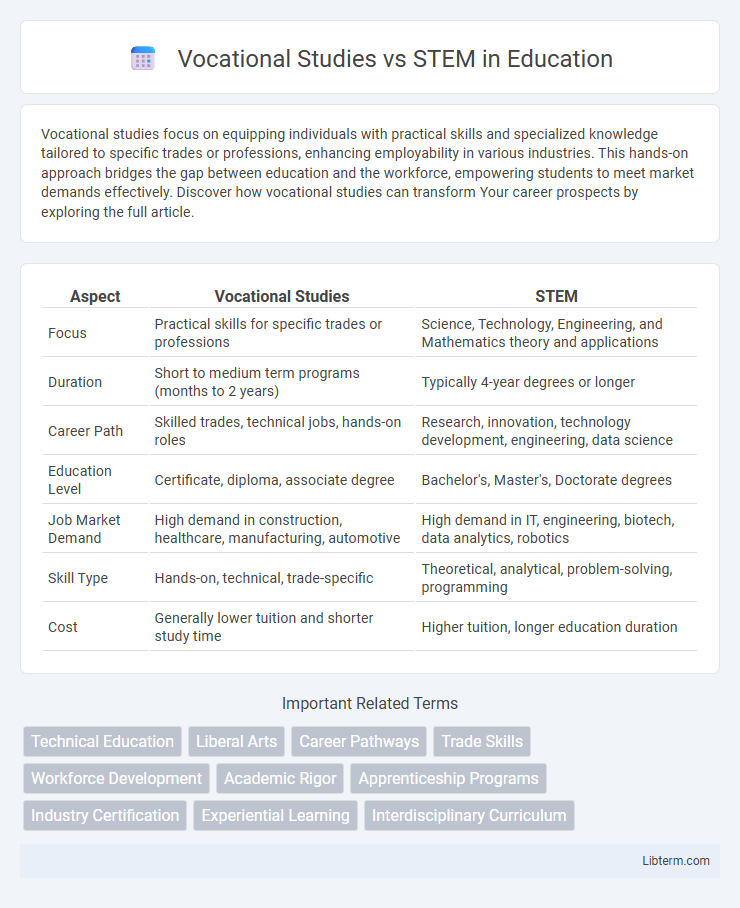Vocational studies focus on equipping individuals with practical skills and specialized knowledge tailored to specific trades or professions, enhancing employability in various industries. This hands-on approach bridges the gap between education and the workforce, empowering students to meet market demands effectively. Discover how vocational studies can transform Your career prospects by exploring the full article.
Table of Comparison
| Aspect | Vocational Studies | STEM |
|---|---|---|
| Focus | Practical skills for specific trades or professions | Science, Technology, Engineering, and Mathematics theory and applications |
| Duration | Short to medium term programs (months to 2 years) | Typically 4-year degrees or longer |
| Career Path | Skilled trades, technical jobs, hands-on roles | Research, innovation, technology development, engineering, data science |
| Education Level | Certificate, diploma, associate degree | Bachelor's, Master's, Doctorate degrees |
| Job Market Demand | High demand in construction, healthcare, manufacturing, automotive | High demand in IT, engineering, biotech, data analytics, robotics |
| Skill Type | Hands-on, technical, trade-specific | Theoretical, analytical, problem-solving, programming |
| Cost | Generally lower tuition and shorter study time | Higher tuition, longer education duration |
Introduction to Vocational Studies and STEM
Vocational Studies emphasize practical skill development tailored to specific trades such as carpentry, plumbing, or culinary arts, providing hands-on experience and direct pathways to employment. STEM (Science, Technology, Engineering, and Mathematics) focuses on theoretical understanding and innovation in areas like computer science, engineering, and biological sciences. Both educational pathways equip students with essential competencies, but Vocational Studies target immediate job readiness while STEM nurtures analytical problem-solving and technological advancement.
Defining Vocational Studies
Vocational Studies focus on practical skills and hands-on training tailored to specific trades or professions, such as carpentry, culinary arts, or healthcare. Unlike STEM fields that emphasize science, technology, engineering, and mathematics theory and innovation, Vocational Studies prioritize workforce-ready competencies and direct job applicability. This educational pathway prepares students for immediate employment by developing technical expertise aligned with industry demands.
Understanding STEM Education
STEM education integrates science, technology, engineering, and mathematics to develop critical thinking, problem-solving, and innovation skills essential for the modern workforce. Vocational studies emphasize practical, hands-on training tailored to specific trades or careers, often enabling immediate employment opportunities. Understanding STEM education highlights its role in fostering interdisciplinary knowledge and preparing students for technology-driven industries, contrasting with the skill-specific focus of vocational programs.
Key Differences Between Vocational Studies and STEM
Vocational studies focus on hands-on training and skill development for specific trades or professions, emphasizing practical application and immediate job readiness. STEM (Science, Technology, Engineering, and Mathematics) education centers on theoretical knowledge, problem-solving, and innovation within scientific and technical fields. The primary distinction lies in vocational studies preparing students for specific careers through applied skills, while STEM focuses on developing analytical and critical thinking abilities for a broad range of technology-driven industries.
Career Opportunities in Vocational Studies
Vocational studies offer specialized training in fields such as healthcare, automotive technology, and skilled trades, providing direct pathways to employment with high demand for practical skills. Careers in vocational studies often require less time and financial investment compared to STEM degrees, leading to faster entry into the workforce and competitive salaries in industries like construction, manufacturing, and culinary arts. The growing emphasis on technical expertise in sectors such as renewable energy and advanced manufacturing further enhances career prospects for vocational graduates.
Career Prospects in STEM Fields
STEM fields, including science, technology, engineering, and mathematics, offer robust career prospects characterized by high demand and competitive salaries. Vocational studies provide practical skills tailored to specific trades, but STEM careers often lead to broader opportunities in innovation-driven industries such as software development, biotechnology, and engineering design. The rapid growth of STEM sectors emphasizes the importance of specialized education and continuous skill development for long-term career advancement.
Skills Development in Vocational vs STEM Programs
Vocational studies emphasize hands-on skills development tailored to specific trades such as welding, plumbing, or healthcare, ensuring students acquire practical expertise directly applicable to their careers. STEM programs concentrate on developing analytical, problem-solving, and technological skills through disciplines like mathematics, engineering, and computer science, fostering innovation and critical thinking. Both pathways cultivate essential competencies, with vocational education prioritizing immediate job readiness and STEM focusing on theoretical understanding and advanced technical abilities.
Societal Impact of Vocational and STEM Education
Vocational studies equip students with practical skills directly applicable to trades and industries, leading to increased employment rates and addressing labor market demands. STEM education fosters innovation and technological advancement, driving economic growth and solving complex global challenges. Both educational pathways contribute significantly to societal development by balancing immediate workforce needs with long-term scientific progress.
Choosing the Right Path: Factors to Consider
Choosing between Vocational Studies and STEM depends on your career goals, learning style, and industry demand. Vocational programs emphasize hands-on training and quick entry into skilled trades, while STEM fields focus on analytical skills, innovation, and higher education. Consider job market trends, salary potential, and personal interests to determine the best educational path for long-term success.
Future Trends in Vocational Studies and STEM
Future trends in vocational studies emphasize integration with advanced technologies such as AI, robotics, and renewable energy, enhancing skill sets for evolving job markets. STEM education continues to drive innovation through interdisciplinary approaches in data science, biotechnology, and cybersecurity, preparing students for high-demand careers. Growing collaborations between vocational institutions and tech industries ensure relevant training aligned with workforce needs and emerging economic sectors.
Vocational Studies Infographic

 libterm.com
libterm.com